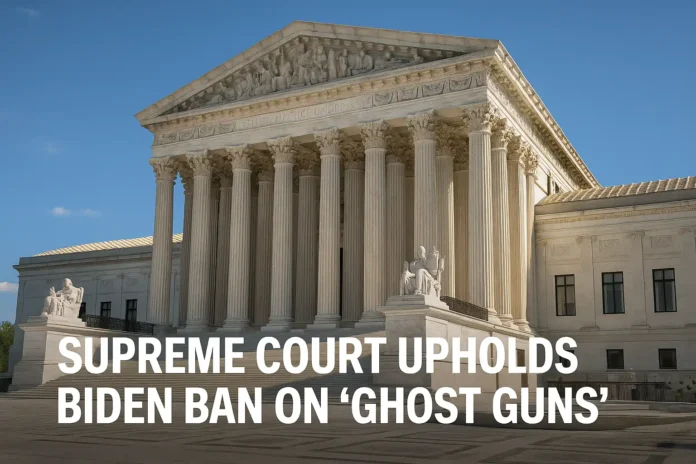Supreme Court Upholds Biden Administration’s Ban on Ghost Guns – A Landmark Ruling on Untraceable Firearms
March 26, 2025 | Washington D.C.
In a major victory for the Biden administration and advocates of tighter gun regulations, the U.S. Supreme Court has upheld federal restrictions on so-called “ghost guns”—untraceable firearms that can be assembled at home from kits ordered online. The 7-2 decision marks a pivotal moment in the ongoing national debate over gun control and public safety, particularly in an era of increasing mass shootings and gun-related crimes.
What Are Ghost Guns?
Ghost guns are privately assembled firearms that lack serial numbers, making them virtually untraceable by law enforcement. These weapons are often sold in the form of “build kits” that can be easily purchased online without a background check. Once assembled, they function like any commercially manufactured gun but bypass traditional regulations.
This legal gray area had made ghost guns especially attractive to individuals looking to evade federal gun laws, including convicted felons and minors.
The Supreme Court’s Decision: 7-2 In Favor of Regulation
The high court ruled in favor of the Bureau of Alcohol, Tobacco, Firearms and Explosives (ATF), which in 2022 issued a rule redefining firearm kits and partially assembled frames or receivers as “firearms” under the Gun Control Act of 1968. The ruling allows the Biden administration’s ghost gun ban to stay in effect, requiring:
- Serial numbers on all firearm parts sold in kits
- Licensed dealers only to sell such kits
- Mandatory background checks
- Recordkeeping of all sales
The majority opinion was authored by Justice Neil Gorsuch, a conservative appointee who surprised many by siding with the liberal justices and moderate conservatives. He wrote that the ATF’s interpretation of the Gun Control Act is well within the bounds of the law, stating:
“Congress defined firearms broadly to include parts that can be ‘readily converted’ into a functioning weapon. The ATF’s rule aligns with that intent.”
Who Dissented – And Why?
Conservative Justices Clarence Thomas and Samuel Alito dissented, with Justice Thomas writing a sharp rebuke of the majority, claiming that:
“The ruling blesses the government’s overreach based on a series of errors… The Court has allowed the Executive Branch to rewrite criminal laws under the guise of regulation.”
Their dissent signals an ongoing ideological divide within the Court on Second Amendment interpretations and the balance between gun rights and federal oversight.
A Shift in Judicial Trend?
This decision represents a notable shift in the Supreme Court’s stance on firearm regulation. In recent years, the Court has leaned heavily toward expanding gun rights:
- In 2022, it struck down a century-old New York concealed carry law, citing individual rights to self-defense.
- In 2023, it overturned a Trump-era ban on bump stocks, a firearm accessory that enables semi-automatic guns to fire like automatic rifles.
However, the ghost gun ruling underscores the Court’s willingness to uphold certain federal regulations, especially those that address growing public safety threats and exploitations of legal loopholes.
Background of the ATF Rule
In 2022, the ATF under President Biden issued a rule closing the ghost gun loophole. The agency reclassified kits and components like unfinished frames and receivers—previously unregulated—as “firearms” under federal law.
This move was prompted by a surge in ghost gun usage in criminal investigations across major U.S. cities. According to the ATF:
- Over 45,000 ghost guns were recovered at crime scenes between 2016 and 2021.
- These firearms were increasingly being used in gang violence, school shootings, and homicides.
Gun rights groups, including the Firearms Policy Coalition and Gun Owners of America, challenged the ATF’s rule in federal courts, arguing that a non-functional kit cannot be legally defined as a firearm.
But the Supreme Court’s ruling effectively puts an end to those challenges, granting the ATF authority to regulate ghost guns as complete firearms.
What This Means for Americans
For law-abiding gun owners and dealers, this ruling reinstates clear federal standards for gun transactions, including background checks and serialization. It also closes loopholes that allowed dangerous weapons to be built and sold without accountability.
For gun rights activists, however, the decision may feel like a loss of personal freedoms and a potential slippery slope toward broader firearm restrictions.
Yet, for law enforcement, school officials, and public safety advocates, the ruling offers a crucial tool to combat gun violence and trace weapons used in crimes.
Key Takeaways:
| Aspect | Details |
|---|---|
| Decision | Supreme Court upholds Biden admin’s ban on ghost guns |
| Vote Split | 7-2 in favor of regulation |
| Majority Opinion | Justice Neil Gorsuch |
| Dissenting Justices | Clarence Thomas, Samuel Alito |
| Legal Basis | Gun Control Act of 1968 |
| Impact | Ghost gun kits now classified as firearms; background checks and serial numbers required |
The Supreme Court’s decision to uphold the ghost gun ban is a landmark moment in modern firearm regulation. As the country grapples with the dual priorities of protecting constitutional rights and ensuring public safety, this ruling sets a legal precedent for tighter oversight of emerging gun technologies.
It also sends a message: while Americans retain their right to bear arms, those rights must exist within a framework of accountability and traceability—especially in a world where a weapon can be built at home with a few clicks and a screwdriver.
For the full ruling, visit: SupremeCourt.gov – Opinion 23-852 (PDF)

